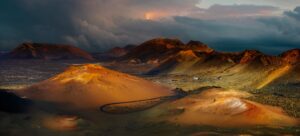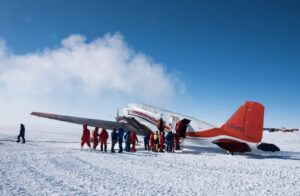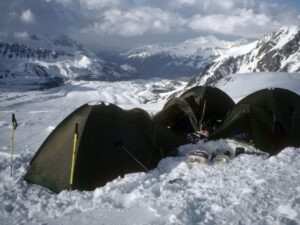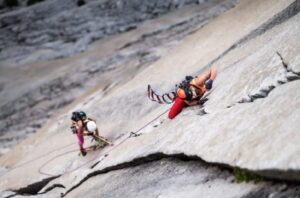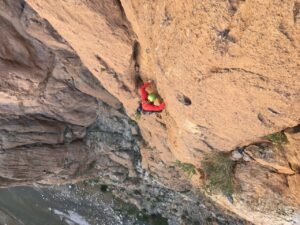In a 3 part series, touching on all 3 of Maciek Tarasin’s expeditions to Chiribiquete, and serialized for ExplorersWeb, the expedition team recount their journey to the legendary “Sistine Chapel” of the Amazon.
In part 1 of the series we joined the team in November 2017, at the outset of their most recent expedition. Part 2 looked back at two of their previous attempts; in 2014 they were halted by FARC activity, and in 2015 Maciek was lucky to survive a pit-viper bite. The final entry in our series picks up where we left off in part 1, with the 4 man expedition’s arrival at the Rio Ajaju river.
Rio Ajaju, December 2017
Senor David and his two companions were saying their goodbyes to the Polish-Irish expedition. Freddy, David’s son-in-law, used to be a taxi driver in the former FARC capital, San Vincente del Caguan. For many years the other Colombian worked in a town called “Quaranta Cinci”, i.e. 45. That was the number of FARC guerrillas stationed nearby.
Initially the river wasn’t even 10 meters wide. The members of the expedition were not certain if it was the Rio Ajaju itself, or just one of its tributaries. For two consecutive days, fallen trees prevented them from making much headway. Michal and Shane were forced to cut their way through the obstructions with machetes. Maciek was occupied fighting off the thick branches, inhabited by enormous black wasps, ants and spiders. They were of little trouble though, compared to the mosquitoes and blackflies. If you stood still for a moment you were attacked by a soundless swarm. The itching intensified when you went to bed. Despite the abundance of insects, fish were scarce and the high muddy banks made camping impossible. The Ajaju was a nightmare.
The party would get up before six, paddle for 10 hours, make a fire whilst swatting insects away, and then go to sleep in their hammocks right after 7 pm. Ten days later, having paddled 300 kilometers, they reached Jaguara Sanctuary and the complex of rock murals on the Ajaju River.
***
They stood in awe, peering at the hundreds of pictographs in red. A collaborative masterpiece, thousands of years old, painted on a fragment of the white wall about 40 meters long and 15 meters wide. Jaguars, tapirs and frogs. Warriors and shamans. An oniric tree with a man picking its fruit, a huge bat and a capybara. But most prominently, jaguars. Jaguars were at the center of the shamanic universe. They were believed to dominate the earth, the water, and the sky. They were the guardians of the rainforest. According to Indian mythology, a jaguar originates from the sun and represents her on the earth. Shamans believed they could transform into a jaguar using hallucinogenic substances like ayahuasca and yoco.
All the paintings seemed chaotic, created in hallucinogenic rapture, the sense behind it all was difficult to grasp: dancing, hunting, animals, plants and people. The Sistine Chapel of the Amazon, at last.
After an hour they turned around. Looking down at the valley of the Rio Ajaju the river was only a lush green carpet of vegetation away.
The following day, Maciek and Dominik wanted to continue their journey up river, to see more of the murals. The other two had a different opinion.
“I am exhausted” Shane explained. “I am not paddling up the Ajaju against the current.”
Maciek tried to convince them that it was worth trying. Seeing the murals had been the expedition’s primary goal. “If the current in the tributary is too strong, we will turn back, but we should at least try” Maciek argued.
“We are not going up the river,” Michał, the expedition photographer, backed up the Irishman, “we can wait for you on the Apaporis.”
But Dominik’s health was a problem, he had not been well. There was no point splitting up.
They elected to stick together and the next few days saw the explorers haul 15km through the virgin rainforest from the Apaporis to San Jorge. It took them two and a half days to hike over the hills, the marshes, and numerous streams. Michał cut a path through the foliage holding a GPS in one hand and a machete in the other. Having left behind the last obstacle, the muddy terrain blocking access to the water, they carried on down the San Jorge river towards El Tubo Canyon. The team were due to be collected from El Tubo by motorboat in three days time. Dominik was still struggling, and Maciek was thinking about calling for medical help. It would be possible to organise quick evacuation to hospital using their Global Rescue Insurance. After a discussion they decided to ask Piotr Chmieliński and Tomasz Jakubiec, both expert kayakers who had supported their expeditions before, for help. It was Piotr who had arranged the boat due to collect them in El Tubo. Time was of the essence and the team would have to pick up their pace.
***
Maciek knew the Rio San Jorge well. Five years before, as perhaps the first white man ever, he descended the river with an Indian guide, Jaime Gomez. Now he would lead this latest expedition down the river. After carrying the packrafts across two waterfalls amongst the headwaters, Maciek guided Dominik through the dangerous rapids. Shane and Michał also took turns leading the way for a few hours. The speed of the current increased quickly and the rapids they were approaching looked to be up to one and a half meters in gradient. “Looks like fun,’’ thought Maciek, “it’s too shallow on the left, and on the right we will get a good mauling from the trees.” He elected to take the middle course, grabbed his paddle and set off. Almost immediately he crashed in to a boulder. He turned around to check on Dominik and saw the fierce waters of the San Jorge spit Dominik out, shooting him through the air like legendary Finnish ski jumper Janne Ahonen.
Finally, and just about in one piece, they arrived within El Turbo canyon.
The most powerful rapids of the Rio Cunare forked out into three channels. Taking the middle option might have been deadly. The river formed a narrow canyon there. Thick tree trunks which made their way in to the channel were left skinned of their bark by the waters power. Maciek knew the passage on the left but they needed to stop to rest. Mesmerized they watched the sunset. The sun was fading into the jungle in a splendid multitude of purple and orange hues. When the show was over, they realized they still had two waterfalls to negotiate. They had to paddle in the dark, with only their headlamp flashlights to guide them, swearing and joking in equal measure. In positive moods they reached a camp, where two years prior they had found an immense turtle. As they were approaching, their eyes searched for people, as that would mean that the boat had arrived. However, no soul – and no boat – was to be seen.
***
Their food supplies were running out and so they went fishing. Maciek stood over a rocky pond watching the fish. It was dark, the only light coming from his headlamp flashlight. Using his machete to spear the fish he worked efficiently. The sack Dominik was holding slowly filled up. They were going to have a feast.
The next day, 10km down the El Tubo, they saw the first boat which had been sent to meet them. The ashes from their fire were still warm. It took them another two days of waiting for the next boat sent by Piotr Chmieliński. As they slowly paddled down the Rio Cunare, they indulged in a discussion on the exquisite taste of juicy pork knuckles, roasted chickens and, first and foremost, beefsteaks. After 4 years of hard work and effort to get to the obscure paintings they recounted stories about delicious dumplings you can get in Warsaw, or the best burgers they make in Żory. The truth of the matter is you can only dream of new adventures on a full stomach.
Previous / Links:
A Journey to the Sistine Chapel of the Amazon Part 1
Surviving FARC and Pit-Vipers: A Journey to the Sistine Chapel of the Amazon Part 2
The River of Traps: A Survival Story
Amazon Explorer Rescued After Pit-Viper Bite

